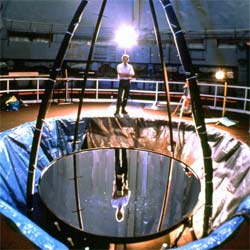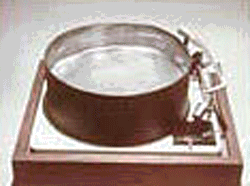Liquid-Solar Telescope
Liquid-Solar Telescope
Surface tension provides a perfectly specular surface without grinding or polishing. As the rotational speed increases, the focal length decreases.
This is a concept by Steve Hines in 1966 to create a telescope mirror with a spinning dish of mercury where gravity and centrifugal force form a parabolic surface. A search done later found prior art for conventional liquid mirrors; however, this relates to solar telescopes which have different requirements.
| A conventional liquid-telescope mirror: | A solar liquid-telescope mirror: |
 |
 |
| Conventional liquid telescope mirrors maximize brightness by using mercury (which is toxic) or gallium-indium-tin alloy (which is very expensive) but which are approximately 95% reflective in the visible spectrum. | The solar liquid telescope mirror, shown at reduced scale, uses oil or blackened ethylene glycol, which evaporate slowly and reflect ≈3%. Additional neutral density filters are used to reduce the brightness to a safe level of ≈0.001%. |
This is not a product for sale. HinesLab currently offers consulting, as well as a variety of licensable technology. Please contact Steve Hines at:
USA
email: [email protected]
ph. 818-507-5812

